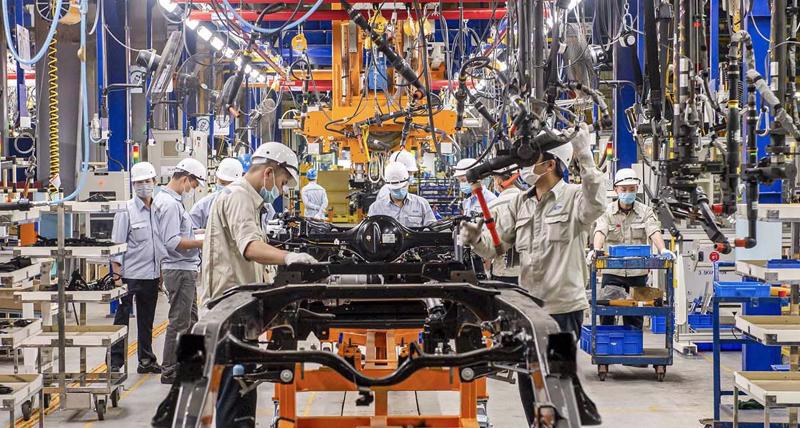Mr. Rizwan Khan, Partner at Acclime Vietnam
Vietnam’s manufacturing and processing sector has been expanding and diversifying across various segments, such as high-tech, food and beverages (F&B), furniture, and garments. It has had many strengths and opportunities over recent years, especially after Covid-19.

Vietnam attracts a great deal of foreign investment and posts high export performance as one of the key manufacturing hubs in Asia, thanks to its young and dynamic population, its location right in the center of ASEAN, its strong political system, its global market reach through free trade agreements (FTAs), and its investor-friendly rules and regulations, to name just a few factors.
In addition to producing traditional goods, it also excels in electronics, telecommunications equipment, machinery, automobiles, oil and gas, and food processing. Vietnam’s manufacturing and processing sector appeals to small and medium-sized enterprises (SMEs) because it has a lower order minimum than China.
The sector attracts foreign investors from around the world but especially from Europe and Asia, which produce the abovementioned non-traditional products.
Foreign investors decide on Vietnam for many reasons, including its large and growing domestic market with a population of nearly 100 million and rising middle class; its young and growing workforce with a high literacy rate and strong work ethic; its relatively low labor costs compared to other Asian countries; its strategic location close to major markets such as China, Japan, and South Korea; and its supportive government, which offers tax breaks and land concessions.
Other reasons include the rise of e-commerce, the desire to diversify away from China, and the government’s focus on manufacturing and processing. Vietnam has also signed many FTAs that offer preferential access to large markets. These factors make Vietnam an attractive destination for manufacturing and processing investment, which creates jobs and boosts economic performance.
It’s fair to say that the manufacturing and processing sector has recorded remarkable achievements in recent years. However, it is also necessary to acknowledge some of the challenges and risks that need to be addressed, such as environmental matters, infrastructure gaps, and issues in technological innovation and competitiveness. The challenges include inadequate infrastructure, a lack of skilled workers, complex regulations, bureaucracy and a formalistic approach, and technological innovation.
In order to overcome these, foreign manufacturing and processing companies could work with local partners that provide access to infrastructure and skilled workers and help navigate the regulatory environment. They need to be proactive in complying with regulations so they can avoid problems with bureaucracy and intellectual property rights (IPR) protection. Moreover, they should expand their networks so they can build relationships with local stakeholders by attending events, meeting officials, and conducting corporate social responsibility (CSR) activities.
A variety of measures could be introduced to support the manufacturing and processing sector, such as reducing barriers to investment and research and development (R&D); developing supporting industries; enhancing human capital development; and promoting green and sustainable manufacturing and processing to reduce costs, risks, and emissions and improve reputation and competitiveness.
Specific measures would include investing in infrastructure, improving the quality of the workforce, simplifying regulations, reducing bureaucracy, further promoting exports, attracting more foreign investment, providing more tax breaks and other incentives to manufacturing and processing companies, establishing special economic zones, creating a network of support services for manufacturing companies, promoting the use of technology, and working with international organizations to promote Vietnam as a manufacturing and processing destination.
In terms of development, the sector has a bright future. It possesses many strengths and opportunities, such as a young and growing workforce, relatively low labor costs, a strategic location, and a supportive government. The government is also investing in infrastructure, improving the workforce, and simplifying regulations.
These will create a better environment for manufactures and processors. The sector will also benefit from the use of advanced technologies such as robotics, artificial intelligence (AI), and big data. These will make Vietnamese manufacturing and processing companies more efficient and productive and help them compete and attract more foreign investment.
Ms. Ngan Dang, Tax Partner at Deloitte Vietnam
Vietnam’s manufacturing and processing sector has witnessed growth for many years, recording a compound annual growth rate (CAGR) of 18.1 per cent in the 2017-2022 period. But it still has room to grow further and attract high-quality investments, particularly FDI. The country holds competitive advantages in a growing domestic market and an ecosystem of FTAs to boost development in the sector. Its population is nearing 100 million, and its middle class is predicted to reach 36 million by 2030. This growing domestic market offers a stable platform for manufacturing companies to serve local demand and exports.

Vietnam also enjoys logistics and commerce benefits from its strategic location, which is convenient for regional and worldwide distribution due to its proximity to important shipping routes. The trade agreements Vietnam has engaged in, notably the Comprehensive and Progressive Agreement for Trans-Pacific Partnership (CPTPP) and the EU-Vietnam Free Trade Agreement (EUVFTA), help lower tariffs and provide new markets for Vietnamese manufacturers.
With the aim of becoming one of the world’s top 15 exporters and an industrialized nation with competitive industries, the Vietnamese Government has introduced many incentive programs such as tax breaks, land grants, and training programs to help enhance industrial development.
Foreign firms aiming to cut manufacturing costs, enter new markets, and take advantage of Vietnam’s economic progress will find it an appealing destination. Recently, major electronics and automotive manufacturers have been drawn to the country because of its role as a manufacturing and processing hub, supply chain integration, skilled workforce, and growing domestic demand.
It is anticipated that between 2025 and 2030, transportation will release between 66,000 and 83,000 tons of carbon dioxide. Prime Minister Pham Minh Chinh pledged at COP26 to reach net-zero emissions by 2050, in order to stop this harmful environmental scenario. This will boost the potential for electric vehicles in the automotive sector.
While the government promotes manufacturing and processing units, both local and international corporations may confront hurdles while operating in the country, such as a complex legal environment, infrastructure limitations, shortages of skilled workers, rivalry, and market saturation.
Therefore, the following steps need to be taken into account: developing infrastructure, simplifying and speeding up administrative procedures, encouraging manufacturing research and development (R&D), boosting vocational training and education, and improving the investment environment.
As a contributor to FDI inflows into Vietnam, incentives in corporate income tax (CIT) rates, customs duties, and land rentals for new investments and expanded projects should be promoted further.
It is worth highlighting that, in recent times, enterprises will have been concerned about the impact of the Global Minimum Tax (GMT) on their overall tax burden on a global basis, so offering an attractive CIT incentive scheme to attract foreign investment may no longer play such a significant role. Given this, we understand that the government is making notable moves in studying such impacts and may soon have practical measures to put into practice to secure the country’s competitiveness.
Vietnam’s economic success story lies in its manufacturing and processing sector, which accounted for 23.6 per cent of GDP in 2022, fueled by FDI and the production of increasingly complex goods. Manufacturing complex goods can drive growth in developing economies.
The export proportion of the FDI sector has been increasing, to over 76.3 per cent of the total, showing that Vietnam’s export growth is increasingly dependent on foreign investment. To reduce this dependence, Vietnam is considering increasing its internal strength through different solutions. First, promoting high-tech FDI. Second, supporting SME growth.
Vietnam’s industrial foundation needs to be enhanced, and private enterprises and startups, most notably in manufacturing and high-technology, are in a good position to develop. Third, strengthening regional cooperation through ASEAN and the RCEP. The ASEAN Connectivity Master Plan 2025 needs an economic and industrial plan. And last but not least, increasing domestic investment and focusing on R&D. An increase in technology use and transfer could help local companies modernize their manufacturing.
Mr. Leif D. Schneider, Senior Legal Adviser at DFDL, and Vice-Chairman of the EuroCham Legal Sector Committee
Vietnam has experienced one of the strongest upticks in manufacturing and processing capacity in the world since the early 2000s. This trend has been further accelerated by the trade tensions between the US and China that kicked off in early 2018. Since then, a palpable shift in global supply chain policies has re-routed many multinational corporations’ sourcing operations.

Vietnam stands out in the ASEAN context as one of the fastest-growing economies globally. It is endowed with a prolific business ecosystem that should tick the boxes of most major manufacturers across all core segments. Consequently, the new wave of market entries in Vietnam’s manufacturing and processing sector has continued making global headlines over the past year, including recent big-ticket manufacturing investments, such as Japanese electronics firm Meiko and Compal Electronics.
At the same time, other manufacturing giants like Samsung, Pegatron, Foxconn, Luxshare, and Goertek are doubling down on their successful Vietnam investments. Some large corporates like Samsung and Bosch have already begun setting firm footholds in Vietnam and kept a steady expansion course in the domestic market.
European investors have been showing increased levels of interest in Vietnam, especially in the high-tech and sustainability segments of the manufacturing and processing industry. European manufacturing capacities in-country have been continuously growing over recent years. The push for European market entry has gained further momentum since Vietnam has entered a new stage of free trade agreement adoption.
The ratification of the EU-Vietnam Free Trade Agreement (EUVFTA) marks a major milestone on this path from a European perspective. The EUVFTA took effect on August 1, 2020, and paves the way for increased trade between the EU and Vietnam and aims to eliminate almost 99 per cent of existing custom duties between member states.
On top of this, Vietnam is also a member of the Regional Comprehensive Economic Partnership (RCEP) and the Comprehensive and Progressive Agreement for Trans-Pacific Partnership (CPTPP), which open the doors to two major trading blocs that cover the majority of the world’s large economies. As the diplomatic rift between the exporting nations of the East and the major importers of the West is becoming more obvious, this situation is bound to further benefit Vietnam.
As a general statement, the path to success when establishing and scaling Vietnamese manufacturing and processing operations is an exercise in careful planning and resilience. In practice, this entails extended project implementation timelines, increased launch budgets, and potential delays in commercial operation dates. To maintain its reputation as a favorable destination for regional and global manufacturing activities, Vietnam would be well-advised to keep improving its regulatory framework for foreign investment and become more administratively efficient. Simultaneously, significant resources must be allocated to the development of key infrastructure that sustains higher technological requirements, as domestic manufacturing activities keep moving up the value chain.
Vietnam is likely to keep benefiting from the matrix of multilateral FTAs it has signed with multiple major stakeholder economies that represent prime offshore markets for Vietnamese-made goods. For foreign investors, this translates into a unique opportunity to leverage Vietnam’s regional potential as a global trade platform. In this sense, Vietnam will probably continue gaining traction as the most viable location in the shift of Chinese manufacturing capacities to alternative destinations.
This strategy, widely known as the “China plus one” strategy, keeps gaining popularity among foreign investors. Because Vietnam remains relatively unaffected by the bipolar economic rivalries between the US and China, it may be able to continue economically prospering in a figurative “eye of the storm”. As mentioned before, its success in doing so will hinge on the efficient and speedy implementation of its FTA commitments and increasing the predictability and reliability of administrative procedures.









 Google translate
Google translate